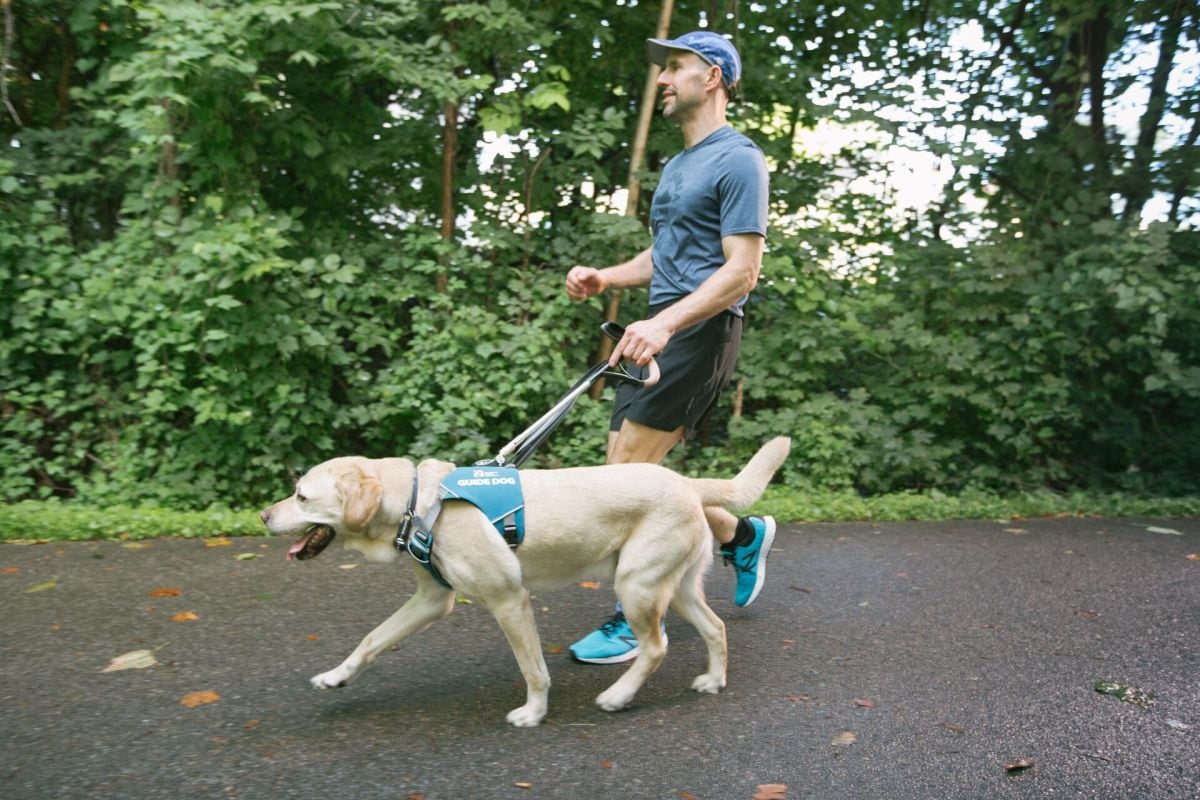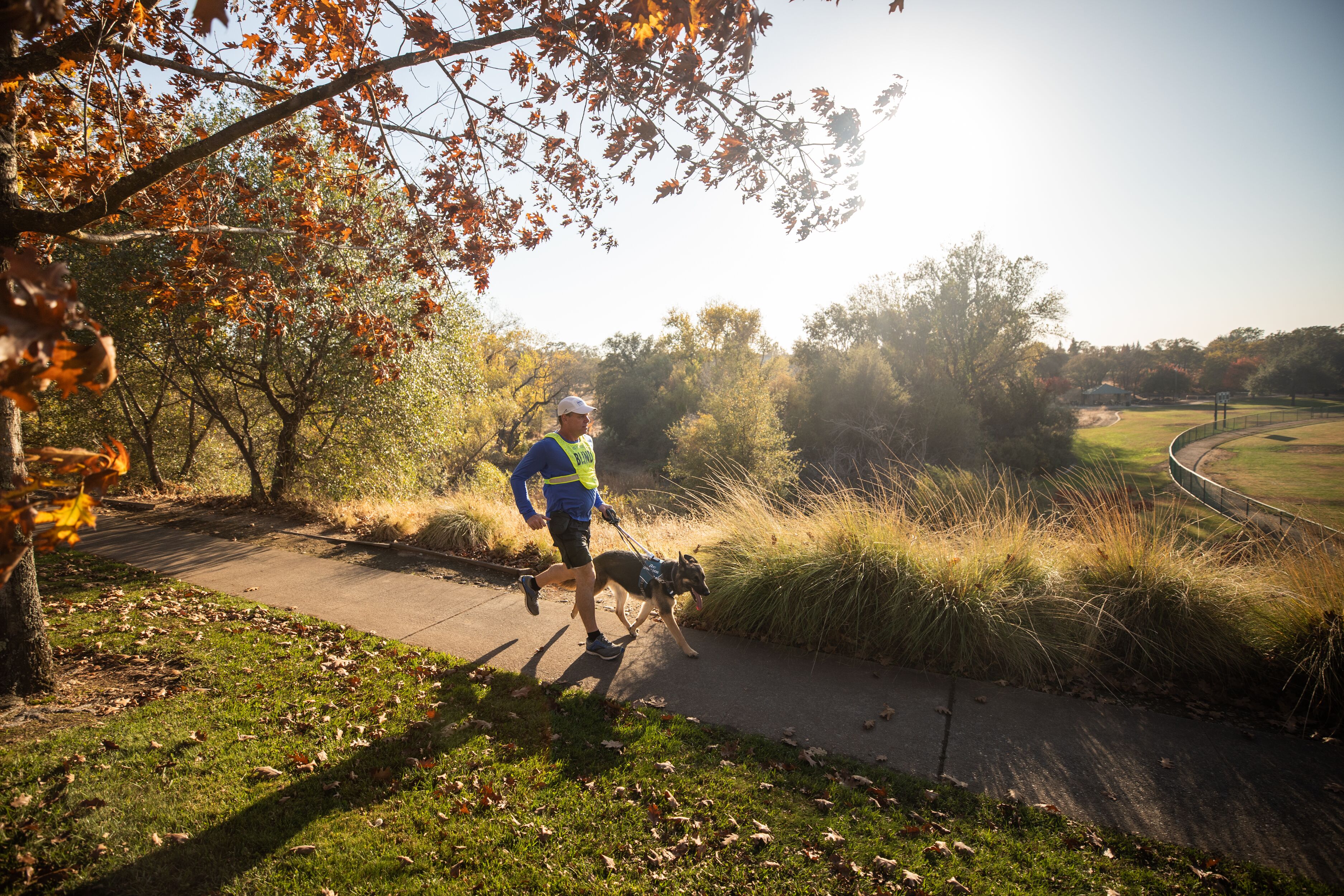This story begins in 2014 at the Boston Marathon. At the end of the race, Thomas Panek, the CEO of Guiding Eyes for the Blind, a nonprofit that trains and provides guide dogs to people with vision loss, and Richard Hunter, an avid runner and former Marine who is visually impaired, asked themselves: What if runners who were visually impaired could use guide dogs instead of human guides to run marathons?
In a matter of months, their idea became reality: Guiding Eyes for the Blind launched its Running Guides program to train guide dogs to run with visually impaired runners. Hunter and his German shepherd, Klinger, were the first graduating team of the program in 2015. Klinger was trained to do things like clearing objects and stopping for changes in elevation like stairs and curbs. He was also taught to guide Hunter on exercise routes at a faster pace than usual using Ruffwear’s Front Range Harness, a popular harness frequently used for running and hiking, modified with a makeshift, two-point handle.
Just that simple modification marked a major shift for the Guiding Eyes program. Prior to 2015, guide dog harnesses had stayed the same: They were made from hard leather, inspired by horse tack used by equestrians. “The traditional leather guide dog harnesses that have been used since the early 1900s were designed for pulling,” said Benjamin Cawley, director of admissions and graduate relations at Guiding Eyes for the Blind. “[They don’t have] the best ergonomics for a dog moving out in a trot comfortably for long distances.”
Guiding Eyes for the Blind, which puts its service dogs through an intensive 12-month training program and then matches each dog with an owner, has been around since 1956. But guide dog schools have been around much longer than that. The first guide dog school opened in 1916, just after World War I, when a German doctor discovered that his dog seemed to be helping a veteran with vision loss find his way. That single observation sparked an idea that would eventually lead to the development of the International Guide Dog Federation, and accredited programs like Guiding Eyes for the Blind.
Since then, both training methods and breeds have changed, but guide dog harnesses have stayed the same. Now, even that has changed.
Shortly after launching their running program, Guiding Eyes for the Blind reached out to Ruffwear to ask if they’d be willing to collaborate on the development of a highly-adjustable, ergonomic harness for the Running Guides program. The result is the Unifly Harness, which Guiding Eyes and Ruffwear began making available to guide dog schools on February 1, 2019.
“We jumped at the chance to help them,” said Greg Freyberg, specialty product line manager for Ruffwear. “We realized we could build a great harness that also works great for a running harness. It was always more than just a running harness.” Ruffwear designers wanted this new harness to be lightweight, adjustable and washable—all things that traditional leather harnesses aren’t.
For example, leather harnesses fit right over the dog’s shoulder joints, which can lead to discomfort for the guide dog while running or after long-term use. And traditional harnesses aren’t height-adjustable, which can be uncomfortable for the person being guided by the dog when wearing taller shoes, like high heels or platform shoes, or when navigating hills. In fact, one woman who completed a Rim-to-Rim of the Grand Canyon needed to buy two separate harnesses—one for the way down and one for the way up. Also, leather harnesses place the runner’s arm in a non-ergonomic position, causing possible damage down the line.
“I was out on the trail thinking through these issues,” said Timothy Gorbold, product designer for Ruffwear. “[My dog and I] were running along, out on this singletrack trail. [I was] looking down at the harness, looking at the B-ring connection right in the center: a center point attachment that can give you lateral control, but also flexibility.”

Photo Courtesy of Ruffwear.
“Where have I seen that type of connection before?” he wondered. Then, it hit him: Nordic ski bindings. When he got home, he attached a Nordic ski binding to a harness, and the harness’ current locking mechanism was born.
The single-point handle offers the same kind of information the two-point handle does, just with an easy way to disconnect and reconnect. This allows the team to convey the important information needed between guide dog and human and easily transition in and out of guiding (most guide dogs are trained to only use the bathroom when off-duty).
“To go from two points of contact to one is pretty revolutionary in the industry,” said Cawley, who extensively tested the Unifly through all phases of its design and currently uses the harness for day-to-day use as well as running. “Many individuals, including myself, who have tried out the harness feel that they are able to feel the dog’s movements better than ever before through the Unifly connection. But I’m biased because I helped design it.”
The handle doesn’t stop there. It’s super adjustable in the length, hand position (now always in a comfortable, ergonomic position) and offset angle. Gorbold, an avid mountain biker, crafted the adjustability like the quick-release in a bike wheel—extend the lever, rotate, change position and flip the lever back down. Even the grip design is crafted to be ergonomic and (thanks to feedback from testers who realized their dog’s legs could get tangled in the loop) snag-free.
Then there’s the harness. It’s not only responsive, but also washable, so trail runs don’t need to stick with you for the rest of your harness’ life. It comes in three colors: an elegant gray, high-visibility yellow and dressed-down blue. The harness and handle attach at the same point as the leash portal of the rest of Ruffwear’s garments, opening up a new world of performance. Guide dogs can now utilize the same gear other dogs have had access to this whole time, from rainwear to cooling vests.
Guiding Eyes for the Blind has been involved in the process every step of the way. From the number of buckles to the size of the neck opening to the feel and size of the handles, testers who are visually impaired have been instrumental in ensuring the finished product was actually what was needed.
“The work that Ruffwear’s done to help make this harness is really part of a really important component of our mission as a guide dog school: helping people achieve greater independence through a guide dog,” Cawley said. “Traditionally runners who are blind or visually impaired can run on a treadmill or ask a friend or volunteer to take them running. This harness opens up more opportunities to enjoy the outdoors.”
The new harness from Ruffwear and Guiding Eyes for the Blind will be available to guide dog schools beginning February 1. Visit Guiding Eyes for the Blind to find out more.
Want to be involved? Become a sighted running guide or, if you live on the East Coast between Maine and North Carolina, consider training to become a puppy raiser with Guiding Eyes for the Blind.
